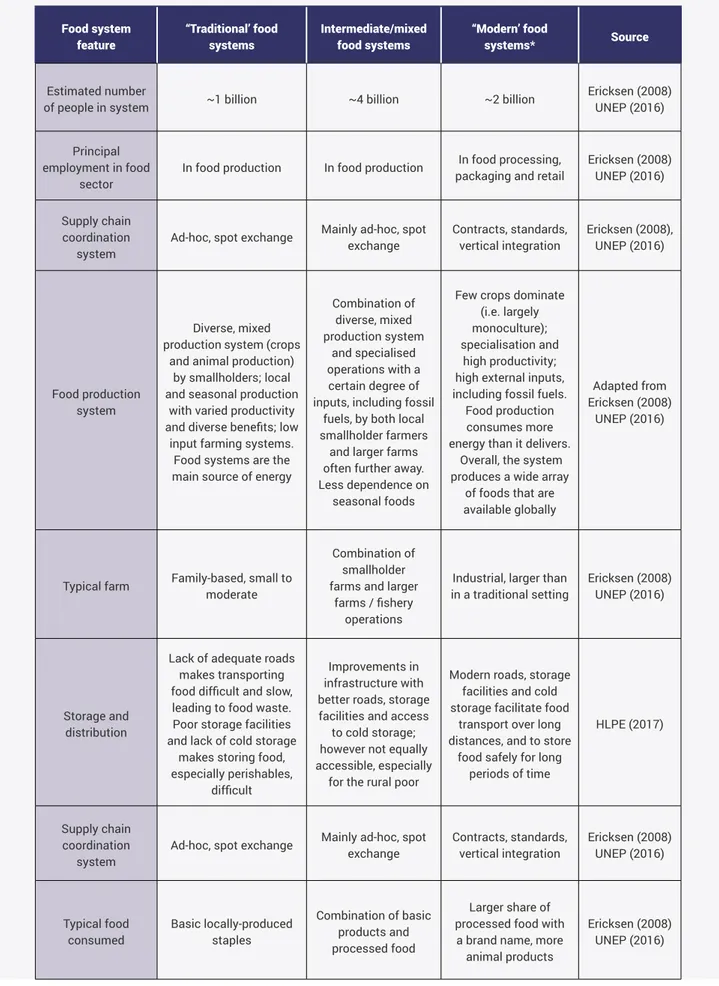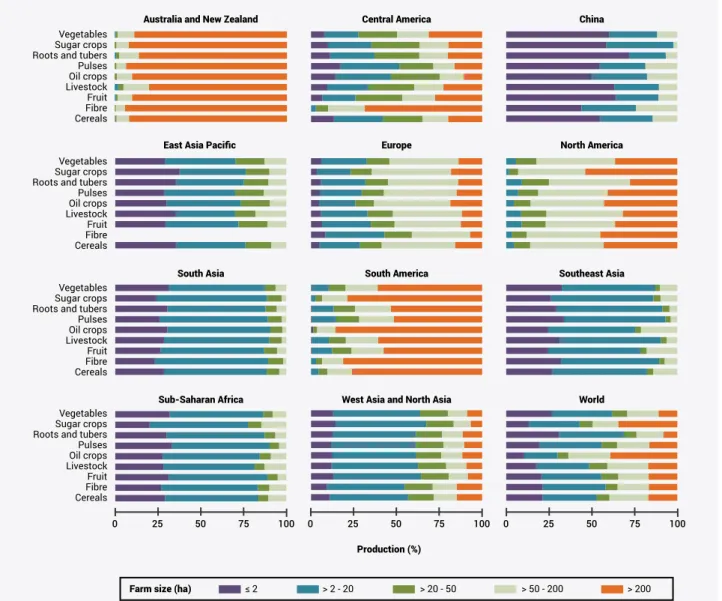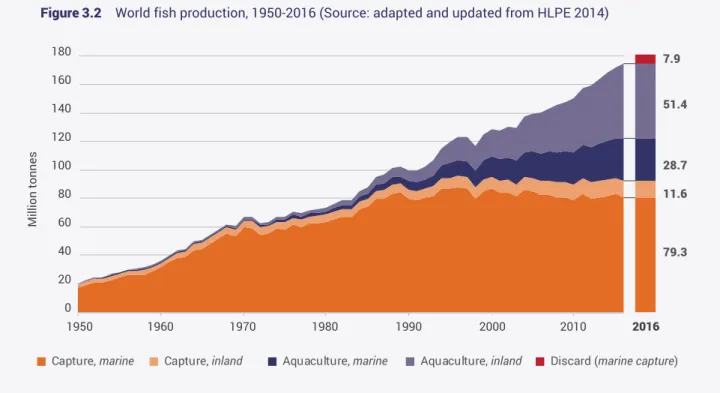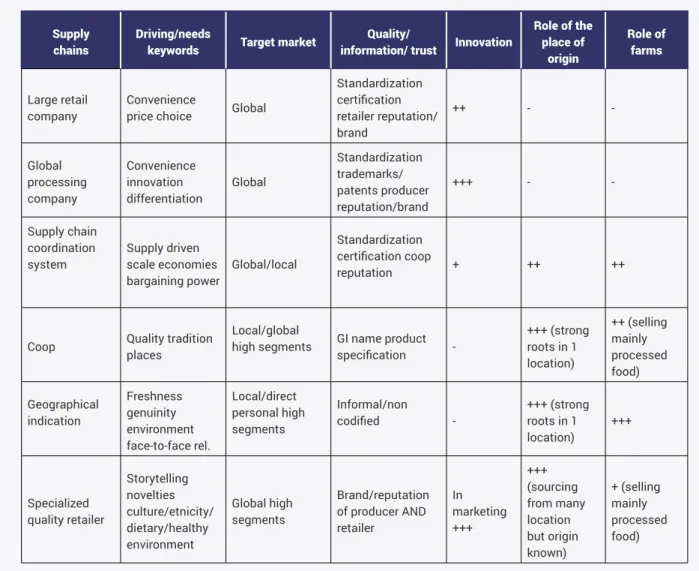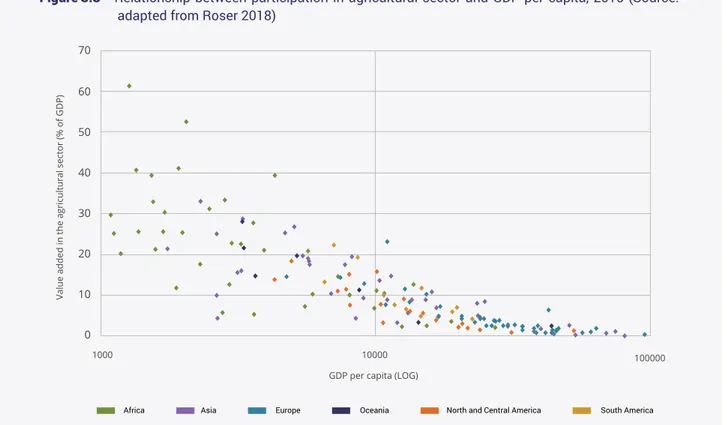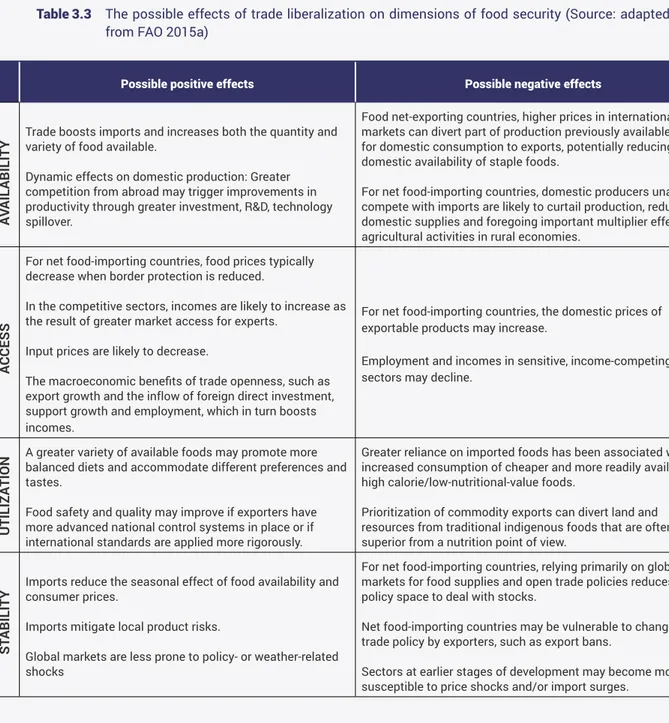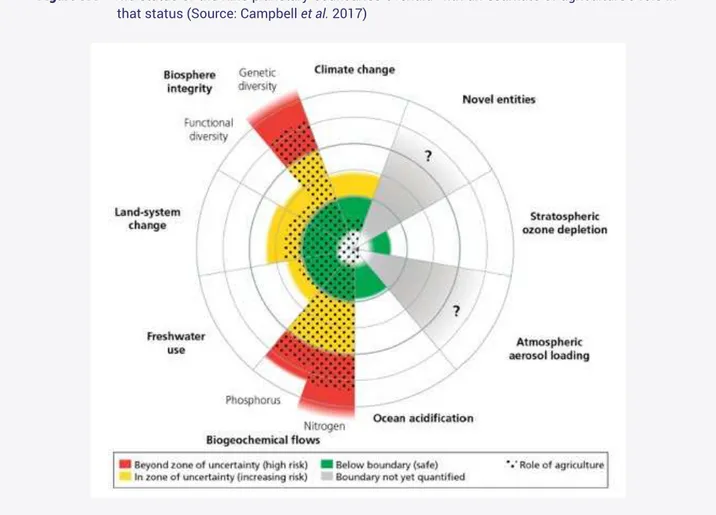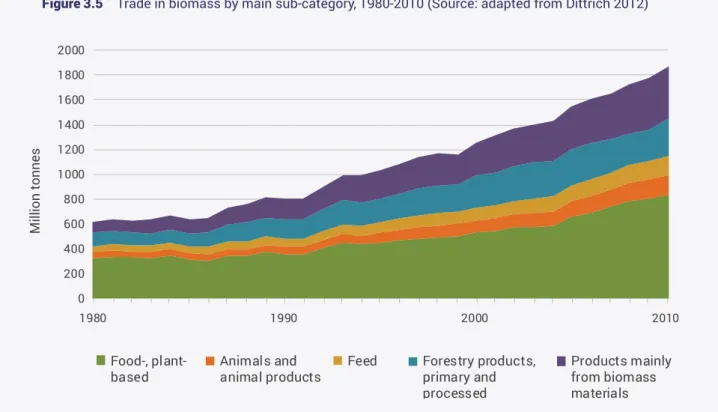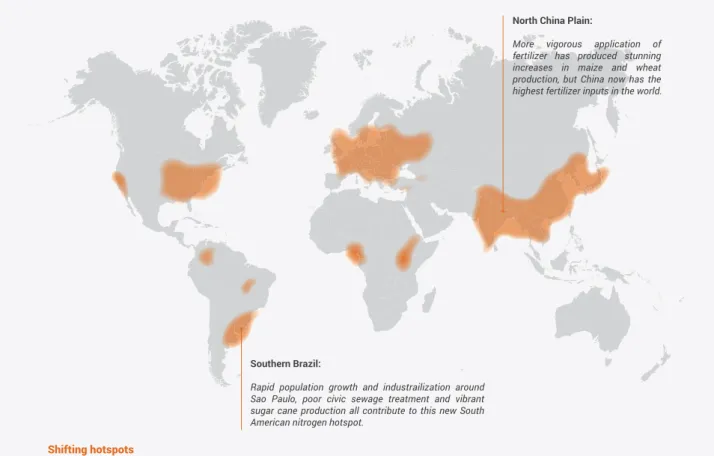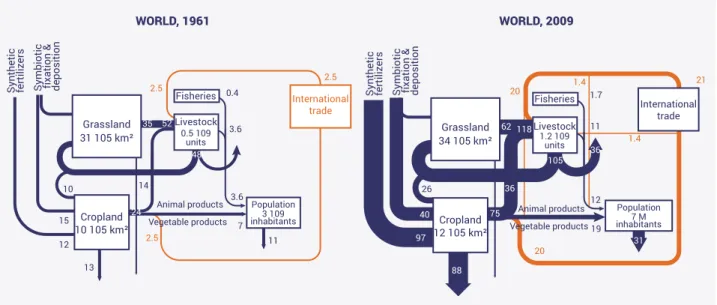White Rose Research Online URL for this paper:
http://eprints.whiterose.ac.uk/164950/
Version: Published Version
Book Section:
Zhang, Wei, Thorn, Jessica Paula Rose, Gowdy, John et al. (32 more authors) (2018)
Systems thinking : an approach for understanding 'eco-agri-food systems'. In:
TEEBAgriFood ‘Scientific and Economic Foundations’ report. TEEB for Agriculture and
Food ‘Scientific and Economic Foundations’ report . The Economics of Ecosystems and
Biodiversity , Geneva .
eprints@whiterose.ac.uk
https://eprints.whiterose.ac.uk/
Reuse
Items deposited in White Rose Research Online are protected by copyright, with all rights reserved unless
indicated otherwise. They may be downloaded and/or printed for private study, or other acts as permitted by
national copyright laws. The publisher or other rights holders may allow further reproduction and re-use of
the full text version. This is indicated by the licence information on the White Rose Research Online record
for the item.
Takedown
If you consider content in White Rose Research Online to be in breach of UK law, please notify us by
3.
CHAPTER 3
ECO-AGRI-FOOD SYSTEMS: TODAY’S
REALITIES AND TOMORROW’S
CHALLENGES
Coordinating lead authors: Walter Pengue (National University of General Sarmiento / University of Buenos Aires) and Barbara Gemmill-Herren (World Agroforestry Centre)
Lead authors: Bálint Balázs (Environmental Social Sciences Research Group), Enrique Ortega (State University of Campinas) and Ernesto Viglizzo (National Research Council, Argentina)
Contributing authors: Francisca Acevedo (National Commission for the Knowledge and Use of Biodiversity, Mexico), Daniel N. Diaz (National Agricultural Technology Institute, Argentina), Diego Díaz de Astarloa (National University of General Sarmiento), Rosa Fernandez (National Agricultural Technology Institute, Argentina), Lucas A. Garibaldi (National University of Río Negro), Mario Giampietro (Autonomous University of Barcelona / Catalan Institution for Research and Advanced Studies, Spain), Andrea Goldberg (National Agricultural Technology Institute, Argentina), Ashok Khosla (Development Alternatives), Henk Westhoek (PBLNetherlands Environmental Assessment Agency)
Review editors: Jessica Fanzo (Johns Hopkins University) and Parviz Koohafkan (World Agricultural Heritage Foundation) Reviewers: Brajesh Jha (Institute of Economic Growth), Asad Naqvi (UN Environment), Unai Pascual (Basque Centre for Climate Change), Ben Phalan (Oregon State University), Jules Pretty (University of Essex) and Kamaljit K. Sangha (Charles Darwin University)
Suggested reference: Pengue, W., Gemmill-Herren, B., Balázs, B., Ortega, E., Viglizzo, E., Acevedo, F., Diaz, D.N., Díaz de Astarloa, D., Fernandez, R., Garibaldi, L.A., Giampetro, M., Goldberg, A., Khosla, A. and Westhoek, H. (2018). ‘Eco-agri-food systems’: today’s realities and tomorrow’s challenges. In TEEB for Agriculture & Food: Scienti c and Economic Foundations. Geneva: UN Environment. Chapter 3, 57-109.
CONTENTS
SUMMARY
Chapter 3 provides an overview of the diversity of agriculture and food systems, each with different contributions to global food security, impacts on the natural resource base and ways of working through food system supply chains. We describe “eco-agri-food systems” and further identify their many manifestations through a review of typologies. We identify challenges ahead with existing systems due to prevailing economic and political pressures resulting in patterns
of invisible ows and impacts across global food systems. We describe pathways to ensure sustainability by securing the bene ts from working with, rather than against, natural systems and ecosystem processes and the challenges for
farmers, communities and societies to reorient food value chains and build resilience in eco-agri-food systems.
FIGURES, TABLES AND BOXES
Figure 3.1 Production of key food groups by farm size
Figure 3.2 World sh production and utilization 1950-2013
Figure 3.3 Relationship between participation in agricultural sector and GDP per capita in several countries, in 2015
Figure 3.4 The status of the nine planetary boundaries overlaid with an estimate of agriculture’s role in that status
Figure 3.5 Trade in biomass by main sub-category, 1980-2010
Figure 3.6 Biomass-based commodity trade between countries
Figure 3.7 Regions of greatest nitrogen use in the world
Figure 3.8 Generalized representation of N transfers through the world agro-food system in 1961 and
2009
Figure 3.9 Virtual water ows between the six world regions
Figure 3.10 Trade balances of virtual land for the EU-27
Figure 3.11 Nutrients exported in soybean products from Argentina (2007-2017) Figure 3.12 Economic growth and prevalence of undernourishment
Figure 3.13 Mapping of value generation in smallholder Asian rice production systems to the Sustainable Development Goals
Figure 3.14 Per capita consumption of meat in selected countries or regions Figure 3.15 Effect of diets on GHG emissions and cropland
Figure 3.16 Sustainable local food system in Chicago
Box 3.1 A brief history of food regimes
Box 3.2 Soybean exportation and nutrient ows
3.0 Key messages
3.1 Introduction to an eco-agri-food system approach
3.2 Typologies of eco-agri-food systems
3.3 Challenges ahead for the world’s agriculture and food systems
3.4 Pathways to sustainability for agriculture and food systems
3.5 Conclusion List of references 66 68 73 77 80 80 81 82 83 84 85 89 94 96 97 100 71 85 59 60 60 72 90 100 102
3.0 KEY MESSAGES
CHAPTER 3
•
This chapter provides an overview of the complexities, roles and functions of eco-agri-food systems. The diversityof global agriculture and food production systems is pro led; the challenges ahead for the world s agriculture and food systems are presented; and pathways to sustainability for agriculture and food systems, building on
ecosystem services and biodiversity, are explored.
•
Globally, there many diverse types of agriculture and food systems, each with different contributions to global food security, impacts on natural resources and varying ways of working through food system supply chains. Using a typology recently adopted by international initiatives, the world’s food systems can be characterized as traditional, mixed and modern. Each of these systems can strengthen their linkages to natural capital and ecosystem service provisioning.•
The contribution of small and medium sized farms of traditional and mixed systems – providing food to an estimated two thirds of the world’s population in highly diverse landscapes – is highlighted, reinforcing the contribution of ecosystem services and biodiversity in food and agriculture.•
Prevailing economic logic reinforces forms of food production that fail to account for the contributions of nature, while negatively impacting both the environment and human welfare. This situation has created externalitiessuch as wide¬spread degradation of land, water and ecosystems; high greenhouse gas emissions; biodiversity losses; chronic over- and undernutrition and diet-related diseases; and livelihood stresses for farmers around the world. The nature of international trade resulting from such forces and pressures has many rami cations for
equity and sustainability.
•
An emerging feature of global food systems is the existence of multiple, insidious forms of visible and invisibleows of natural resources. Socio-economic crises and the often-unpredictable impacts of climate change present
additional and compounding challenges for farmers and local communities.
•
Pathways to sustainability, going forward, must recognize and strengthen those forms of agricultural production that explicitly enhance biodiversity and ecosystem services and build the natural capital that underpins food systems, creating regenerative forms of agriculture and food systems that generate positive externalities.•
Pathways to sustainable food systems must look at the dependencies and interactions within the entire food chain and at multiple scales, from farm to landscape to city to regional food systems.CHAPTER 3
ECO-AGRI-FOOD SYSTEMS: TODAY’S
REALITIES AND TOMORROW’S
CHALLENGES
3.1
INTRODUCTION TO AN
‘ECO-AGRI-FOOD’ SYSTEM
APPROACH
Food—the ultimate source of energy and nutrients—is the central reason for agricultural production around the world (TEEB 2015) and sustains human life (Vivero-Pol 2017). The increasing complexity of the global food system and its intricate linkages with other systems related to energy, health, soils, water, human knowledge, ecosystems, etc. are changing how food systems function. To grasp this complexity and deepen the understanding of the role and function of food systems, TEEB for Agriculture & Food (TEEBAgriFood) is presenting a broadly encompassing perspective that goes beyond the production, processing,
transport and consumption of food. As de ned by TEEB,
an ‘eco-agri-food’ system refers to the vast and interacting complex of ecosystems, agricultural lands, pastures,
inland sheries, labour, infrastructure, technology, policies,
culture, traditions, and institutions (including markets) that are variously involved in growing, processing, distributing and consuming food.
This chapter explores the underpinnings of the
’eco-agri-food system , rst by reviewing the predominant trends
and patterns in the ways that agriculture and food goods are being produced globally. As human populations have grown over time, agriculture and food production systems have experienced dramatic changes, increasing the levels of production well beyond what could have been imagined a hundred years ago. Yet as these systems have become
increasingly productive and global in nature, signi cant
challenges are impacting upon them. Global issues related to food security and sovereignty, nutrition and health, climate change, migration and economic crises show that current food systems are not functioning adequately and are in dire
need of recon guration. Since the 1950s, with the growing
demand for agricultural produce, many farmers began using non-renewable energy-based chemical fertilizers
and agricultural processes became specialized and more monocultural. Ways of processing and distributing food have emphasized low cost and high productivity while often devaluing the freshness or wholesomeness of food. We must be reminded that agriculture and food production are fundamentally biological processes, reliant on biodiversity and ecosystem functions and processes. Agriculture imposes a heavy toll on the environment when it tries to escape its essential biological limits, yet at the same time these ecological functions are key to the sustainability and regenerative potential of farming and food systems. Many multinational, national and local organizations and initiatives are attempting to change the existing pattern so that proper balance with environment is created and any
con ict (economic, political, social) is minimized. TEEB is
one of these efforts, in particular seeking to develop the tools to value ecological functions that contribute to our food system, and the negative and positive externalities that emanate from managing theses agricultural and food systems. TEEBAgriFood aims to offer an integrated and holistic perspective that brings such issues into focus. In this chapter, we unpack the eco-agri-food system, and identify its many manifestations through a review of typologies (Section 3.2). We then identify the challenges
ahead (Section 3.3) and nish with a section (Section 3.4)
describing pathways to improve the status of agricultural
and food systems by securing the bene ts derived from
working with, rather than against, natural systems and ecosystem processes.
3.2
TYPOLOGIES OF
ECO-AGRI-FOOD SYSTEMS
3.2.1 De nition of eco-agri-food systems
In Chapter 1, the eco-agri-food system was introduced. In Chapter 2, generic features of eco-agri-food systems weredescribed, and the importance of understanding multiple interactions and dynamics through systems thinking was highlighted. In this chapter, we aim to unpack those generic features, and characterise the diversity and salient aspects of the main food systems found around the globe that are of relevance to a TEEBAgriFood analysis.
3.2.2 Characterizing the diversity of
eco-agri-food systems
At a broad spatial scale, one may de ne an agricultural
system as the land area in a region, district, or landscape that produces a particular commodity or various crops (Jones et al. 2016). TEEB (2015) de nes agricultural system’ as an assemblage of components which are united by some form of interaction and interdependence and which operate within a prescribed boundary to
achieve a speci ed agricultural objective on behalf of the bene ciaries of the system . For our purposes, we
are focusing on agricultural systems with respect to the integration of their different components such as
natural resources, energy, labour, marketing, nances,
genetic stock, nutrition, equipment, and hazards—thus
the broader food system. This has been de ned as the
interdependent sets of enterprises, institutions, activities and relationships that collectively develop and deliver material inputs to the farming sector, produce primary commodities, and subsequently handle, process, transport, market and distribute food and other agro-based products to consumers (UNEP 2016). It thus includes production, harvesting, storage, processing, packaging, marketing, trade, transport, demand, preparation, consumption and food disposal. It thus includes production, harvesting, storage, processing, packaging, marketing, trade, transport, demand, preparation, consumption and food disposal. As a system, it extends to inputs needed and outputs generated at each step as well as governance,
research, education and varied (e.g. nancial) services
around food provisioning.
Food (value) chains are one of the core elements of a food system that feed a population. Clearly, value chains are created around economic value and respond to supply and demand. However, they can also impact and be impacted by issues related to the environment, nutrition, equity, quality, cultural acceptability of food. Food systems also include political, economic, socio-cultural and environmental drivers and outcomes that
affect actors and stakeholders. Thus, the de nition of
food systems should include activities (from production to consumption), outcomes of the activities (food security, ecosystem services, biodiversity, social welfare), and interactions between and within biogeophysical and human environments (Ericksen 2008). The interactions among these components may become more important than how each component functions independently.
Diversity in agriculture is the result of the co-evolution, in time and space, of human societies and ecosystems, through the practice of farming, unfolding in different patterns of resource use and development trajectories (Ploeg and Ventura 2014). The heterogeneity of farming
systems re ects the diversity of social, economic and
ecological responses to changing adaptive conditions in different settings (Ploeg 2010).
Certainly, there are unlimited permutations of the components of eco-agri-food systems, and a great number of ways of characterizing these. Often contrasting systems are described as dichotomous entities, from traditional peasant systems to “modern” food systems, or as those characteristic of developed versus developing countries. From the TEEBAgriFood perspective, there are many different types of agriculture and food systems, each with different contributions to global food security and different impacts on the natural resource base. If we are to better understand the possible pathways towards sustainable food systems and to encourage intervention from different stakeholders around the world, we need a workable way of characterizing this diversity.
Within a TEEBAgriFood perspective, we suggest it is most productive to adopt current typologies as developed by ongoing international processes, and to take these as a starting point to further describe the pathways that diverse systems may take to recognize externalities and reorient toward more sustainable solutions. A useful typology is that developed by the International Resource Panel of the United Nations Environment (UNEP 2016) and the related High-Level Panel of Experts on Food Security and Nutrition’s report on Nutrition and Food Systems (HLPE 2017).
The International Resources Panel recognizes the diversity of food systems across the world, and their multifarious interactions: nonetheless, distinguishing between traditional food systems, mixed food systems, and modern food systems can be helpful. Salient characteristics of these, relevant for the TEEBAgriFood
Evaluation Framework, are described below (UNEP 2016;
HLPE 2017).
Before presenting the aligned typologies of the HLPE and UNEP, we should note that the Global Nutrition Report
(IFPRI 2015) has developed a food system classi cation
on a country level that considers differences between industrial, mixed, transitioning, emerging and rural food
systems; this typology maps to the three classi cations
mentioned above (and by the International Resource Panel
and the HLPE Report), but with a ner level of distinction
and disaggregation to national levels.
The three classi cations traditional food systems,
modern food systems, and mixed food systems - are described in detail in Table 3.1 and the sections below
(while noting that these are not distinct categories, but rather a way of classifying a complex continuum):
Traditional food systems: These may also be considered low-external input-intensive food systems, which primarily make use of naturally generated inputs, human knowledge and skills, and production practices that have been maintained by communities over generations. Yields and productivity tend to be low in comparison to high-input systems, although societies within traditional food
systems generally value bene ts well beyond production
and income. Under often challenging biophysical conditions, traditional food systems have often developed ways of sustaining agricultural production in places where modern, mechanized agriculture would not succeed. Agricultural products are either self-produced or sold in local markets and are largely unprocessed, or are processed by the local consumers. Production, trade and processing takes place in small-scale operational units. Linkages with larger commercial operations are scarce. Consumption patterns correspond to seasonal harvests, and are usually dominated by plant-based products, (although a considerable component of traditional
communities such as pastoralists, sherfolk, and forest dwellers may specialize in livestock, sh or wild meat and
honey, respectively). Access to perishable foods such as certain fruits and vegetables and animal source foods
depends on proximity to the source; thus, local markets are
highly important for food security and nutrition. As food security primarily depends upon local sources, pressures on these sources such as extreme weather events or population changes demand new, usually local responses. Examples of traditional food systems include Andean agricultural systems where farming communities cultivate more than 1,000 native varieties of potatoes adapted to different environments ascending the Andes under terrace management. The Ifugao rice terraces in the Philippines
have retained their viability and e cacy over 2000 years
in a system intimately intertwined with that of the local communities’ culture and beliefs, religious rituals and traditional environmental management and agricultural practices (Koohafkan and Altieri 2011).
Traditional food systems often include an important livestock component, such as pastoralism. The Maasai in Kenya and Tanzania, for example, practice a pastoral system, in its essential elements, that is over 1000 years old. To this day, it strikes a social and environmental balance in a fragile environment, sustaining livestock production and conserving critical habitat for wildlife (Koohafkan and Altieri 2011). In Europe, the transhumant pastoralists in Eastern Spain, or the Sami people in the artic are among hundreds of good examples of communities employing traditional food systems.
Small-scale sheries are another important production
system for subsistence or local markets, often using
traditional shing techniques and small boats. Collectively, small-scale sheries catch a large proportion of all sh
caught for human consumption, and employ 90% of the
labour involved in capture sheries (FAO 2016b).
Traditional systems tend to have low use of external inputs and focus on stability rather than increase in production. Communities practicing traditional systems sustain themselves by engaging in cultural activities that, tied to the traditions of certain communities and inherited forms of production, replicate and improve their own production and consumption systems, incorporating cultural and religious elements, as well as social practices, for the management of resources.
Modern food systems: These are systems that are
generally characterized as high external-input, high productivity systems, with a strong dependence on purchased or external inputs such as modern crop seeds, fertilizers, pesticides and fuel-based mechanical inputs. There is a strong economic incentive to avoid risks of crop loss by over-applying both pest control and fertilizers, resulting in on-site pollution, run-off and contamination of adjacent land and water. The impacts of intensive agricultural systems on soil health, freshwater quantity and quality, greenhouse gas emissions, and the capacity to conserve biodiversity and generate ecosystem services may be strongly negative
(Pingali 2012; Godfray et al. 2010).
While farming systems may be considered “modern”, farmers around the world are generally operating at small margins, sometimes compensated by government subsidies. Capacities to invest in more regenerative practices are thus limited. Crops and livestock rearing systems, often closely connected in traditional systems, are generally separated in modern food systems. The processing, distribution and retail sides of the food chain in modern food systems are usually specialized and elaborate, and provide substantial employment and value addition, but are also greenhouse gas-intensive. The modern food system is characterized by specialized input producers and agricultural companies, operating at large and often transnational scale. The production focus now includes not only food for direct human consumption, but also biofuels and animal feed. The processing and retail segments of modern food systems have a major
in uence on both production systems and consumer
behaviour. Consumers in modern food systems have the choice to purchase food from sources all over the world, much of it in a processed form. However, “food deserts1” and “food swamps2” may be common in
low-1 Described as geographic areas where residents’ access to food is restricted or non-existent due to the absence or low density of “food entry points” within a practical travelling distance (HLPE 2017) 2 Described as geographic areas where there is an overabundance of
income areas, creating areas of food insecurity within modern food systems. Consumption of meat, trans fats and sugary foods is much higher in modern systems than in other food systems. The cost of staples, such as rice
and wheat our, is lower than animal-sourced foods and
perishable fruits and vegetables. Consumers have access to fairly complete information on food labels, and dietary guidance is widely disseminated, though not necessarily widely used. Modern food systems are associated with comparatively lower levels of undernutrition (although concentrated areas do occur), but higher levels of overweight and obesity (Ng et al. 2014).
More recent trends in modern food systems include greater reliance on modern biotechnology such as
genetic modi cation, molecular markers, hydroponics and
precision-farming tools (e.g. GPS, GIS, satellite images, automatic mapping) and procedures that increase
the application e ciency of inputs (Pingali 2012). For
example, in places with land or weather constraints, experimentation with hydroponics is underway. In Japan, rice is harvested in underground vaults without the use of soil. Israel also, where the management of water is a key point, is experimenting with these new tools and innovations. In USA, hydroponics farming revenues reached $821 million nationwide in 2016, growing at a rate
of four to ve per cent since 2011, with 2,347 hydroponic
farms (Ali 2017).
A parallel trend within modern food systems is a return to
more organic, local/small-scale and diversi ed practices,
from production to retail sales. Major aspects of this trend can be captured under the umbrella of agroecology, in its different aspects as a science, a practice and a movement (Wezel et al. 2009). As a science, agroecology reorients agronomic science to build on the ecological foundations of farming and agriculture, combining different elements of nature and its services to maximize synergies between
them. As a practice, agroecology is not prescriptive; it
is based on applying a set of principles (for example, “enhance recycling of biomass, optimizing nutrient
availability and balancing nutrient ow ) to local contexts
(TWN-SOCLA 2015). As a social movement, the focus of
agroecology has moved from the eld and farm scale
to the entire food system, emphasizing the importance of building food networks that link all parts of the food system, and advocating for social equity and food system transformation (Gliessman 2015). The farming traditions
that re ect the application of agroecological principles in
one form or another include: ‘permaculture’ associated with the ecologist Bill Mollison, ‘biodynamic farming’ following the principles of the anthroposophist Rudolf Steiner, the ‘one-straw revolution’ founded by the Japanese farmer Masanobu Fukuoka, the ‘Biointensive’ farming system popularized in the U.S. by John Jevons, the ‘No Tillage’ movement in Brazil led by Ana Primavesi, ‘Agroecology’ as described by Miguel Altieri and Stephen Gliessman in the U.S., Latin America, Africa and Asia, and the wide range of
farming systems that in one way or another subscribe to
the formal de nition of organic farming institutionalized
by the International Federation of Organic Agriculture Movements (IFOAM). These food systems are often meant for international markets, but also used for home consumption, solidarity markets and other approaches to land and food sovereignty such as promoted by La Via Campesina, the international movement of Agrarian Federations for Farmers in the world.
Mixed food systems: While most ’modern’ food systems may be found in Europe, the U.S. and other industrialized countries, and ‘traditional’ food systems are far more common in less industrialized regions, a vast range of intermediate, or ‘mixed’, food systems exist throughout the globe, supplying food to an estimated four million people. Particularly in Latin America, Asia, Eastern Europe and in some African countries, small and medium-sized farms provide the majority of food to local and national populations. In mixed systems, farmers integrate or incorporate some elements of different technological
packages; for example, they may use pesticides and
fertilizers, but plant farmer-saved, traditional varieties. Food producers rely on both formal and informal markets to sell produce. The food systems, however, are not
uniformly small scale; the processing and retail segments
of the system are often quite commercialized and in the process of becoming linked into regional and global value chains. Consumers may purchase most of their food in local or street markets, but other supermarkets and processed food purveyors are growing as market presences. Processed and packaged foods are more accessible than under traditional food systems, while nutrient-rich foods, such as fruits, vegetables and nuts, are more expensive. A further notable change is that food advertising is pervasive, and while food labelling may appear on packaged foods, most consumers are not well informed on dietary guidelines and use of labelling to balance diets. Malnutrition, both in terms of undernutrition and overweight/obesity, occurs in intermediate or mixed food systems, with many challenges remaining on how to address these both in policy and programmes.
Current trends in intermediate (mixed) food systems include the growing importance of urban agriculture, in developed and developing countries alike. For example, urban horticulture in the Congo reaps $400 million for small growers, giving incomes, and labour and food security (FAO 2011b).
Table 3.1 Details of the key features of these food systems typologies, which serve to distinguish key elements across a complex continuum from traditional to modern
Food system feature Traditional food systems Intermediate/mixed food systems Modern food systems* Source Estimated number
of people in system ~1 billion ~4 billion ~2 billion
Ericksen (2008) UNEP (2016)
Principal employment in food
sector
In food production In food production In food processing,
packaging and retail
Ericksen (2008) UNEP (2016)
Supply chain coordination
system
Ad-hoc, spot exchange Mainly ad-hoc, spot
exchange Contracts, standards, vertical integration Ericksen (2008), UNEP (2016) Food production system Diverse, mixed production system (crops
and animal production) by smallholders; local and seasonal production
with varied productivity and diverse bene ts; low
input farming systems. Food systems are the main source of energy
Combination of diverse, mixed production system and specialised operations with a certain degree of inputs, including fossil
fuels, by both local smallholder farmers
and larger farms often further away. Less dependence on
seasonal foods
Few crops dominate (i.e. largely monoculture); specialisation and
high productivity; high external inputs, including fossil fuels.
Food production consumes more energy than it delivers.
Overall, the system produces a wide array
of foods that are available globally
Adapted from Ericksen (2008)
UNEP (2016)
Typical farm Family-based, small to
moderate
Combination of smallholder farms and larger
farms / shery operations
Industrial, larger than in a traditional setting
Ericksen (2008) UNEP (2016)
Storage and distribution
Lack of adequate roads makes transporting food di cult and slow, leading to food waste. Poor storage facilities and lack of cold storage
makes storing food, especially perishables,
di cult
Improvements in infrastructure with better roads, storage facilities and access
to cold storage; however not equally accessible, especially
for the rural poor
Modern roads, storage facilities and cold storage facilitate food
transport over long distances, and to store
food safely for long periods of time
HLPE (2017)
Supply chain coordination
system
Ad-hoc, spot exchange Mainly ad-hoc, spot
exchange Contracts, standards, vertical integration Ericksen (2008) UNEP (2016) Typical food consumed Basic locally-produced staples Combination of basic products and processed food Larger share of processed food with
a brand name, more animal products
Ericksen (2008) UNEP (2016)
Processing and packaging
Basic processing is available such as drying
fruit, milling grains or processing dairy products. Little or limited
packaging occurs
Highly processed packaged foods emerge and are more
accessible
Many processed packaged foods are easily available, often cheap and convenient to eat, but sometimes
unhealthy
HLPE (2017)
Food bought from retail/market
Small, local shop or market
Small, local shop or market, share of
supermarkets small but rapidly
growing
Predominantly large supermarket chain, food service and catering (out of home)
Modi ed from HLPE (2017) Nutritional concern Undernutrition, and micronutrient de ciencies Both undernutrition and diet-related diseases
Diet-related diseases Ericksen (2008)
UNEP (2016)
Economic access (affordability)
Food is a large portion of the household budget. Staples tend to be signi cantly less
expensive relative to perishables (animal source food, fruits and
vegetables)
Food places moderate demands
on household budgets. Staples are inexpensive, whereas perishable foods are
expensive. Many highly processed and convenience foods are
inexpensive
Food demands less of the household budget. The price of staples
is lower relative to perishables, but the difference is less stark
than in the other food systems
HLPE (2017a)
Main source of national food
shocks
Production shocks International price and
trade problems
International price and trade problems Ericksen (2008) UNEP (2016) Main source of household food shocks
Production shocks; may be more resilient than capital-intensive systems (see Altieri 2002) International shocks leading to food poverty International shocks leading to food poverty
Ericksen (2008) UNEP (2016) Altieri (2002) Major environmental concerns
Soil degradation, land clearing, water shortage
Combination of concerns in traditional and modern systems Emissions of nutrients and pesticides, water demand, greenhouse gas emissions, and others due to fossil
fuel use
Ericksen (2008) UNEP (2016)
In uential scale Local to national Local to global National to global Ericksen (2008) UNEP (2016)
*It should be noted that the parallel trends within modern food systems as noted above - fostering
3.2.3 Differential contribution of diverse
food systems to global food and nutrient
production
A basic typology of food systems (traditional, intermediate/mixed and modern) permits a more focused consideration of how different food systems contribute to global food and nutrient production. A key point from a recent paper by Herrero et al. (2017) is that understanding the differential contributions of diverse food systems is essential. Within this paper, the authors provide a breakdown not just of global agricultural production but also of nutrient production, by farm size. While there are no clear cut-offs in farm size between different food systems, small to medium sized farms tend to be found in traditional and mixed food systems, while larger industrial farms are part of modern food systems.
The Herrero et al. (2017) report nds that globally, small and
medium farms ( 50 ha) produce 51 77 per cent of nearly
all commodities and nutrients examined here, with key regional differences. As can be seen in Figure 3.1, small
farms ( 20 ha) produce more than 75 per cent of most food
commodities in the populous regions of Sub-Saharan Africa, Southeast Asia, South Asia, and China. Very small farms
( 2 ha) are important and have local signi cance in
Sub-Saharan Africa, Southeast Asia, and South Asia, where they contribute to about 30 per cent of most food commodities. In Europe, West Asia and North Africa, and Central America, medium-size farms (20–50 ha) also contribute substantially to the production of most food commodities. Large farms (>50 ha) dominate production in North America, South America, and Australia and New Zealand. In these regions, large farms contribute between 75 per cent and 100 per cent of all cereal, livestock, and fruit production. This pattern is similar for other commodity groups.
Figure 3.1 Production of key food groups by farm size (Source: adapted from Herrero et al. 2017)
Vegetables Sugar crops Roots and tubers Pulses Oil crops Livestock Fruit Fibre Cereals Vegetables Sugar crops Roots and tubers Pulses Oil crops Livestock Fruit Fibre Cereals
Australia and New Zealand Central America China
East Asia Pacific Europe North America
South Asia South America Southeast Asia
World
Sub-Saharan Africa West Asia and North Asia
0 25 50 75 100 0 25 50 75 100 0 25 50 75 100
Vegetables Sugar crops Roots and tubers Pulses Oil crops Livestock Fruit Fibre Cereals Vegetables Sugar crops Roots and tubers Pulses Oil crops Livestock Fruit Fibre Cereals Production (%)
Herrero et al. (2017) also looked at how the diversity of food production changes with the diversity of agricultural landscapes and production systems. They documented that the majority of vegetables (81 per cent), roots and tubers (72 per cent), pulses (67 per cent), fruits (66 per
cent), sh and livestock products (60 per cent), and
cereals (56 per cent) are produced in diverse landscapes (taken as the number of different products grown within a geographic area). Similarly, the majority of global micronutrients (53–81 per cent) and protein (57 per cent) are also produced in more diverse agricultural landscapes. By contrast, the majority of sugar (73 per cent) and oil crops (57 per cent) are produced in less
diverse ones (H 1·5), which also accounts for the majority
of global calorie production (56 per cent). The diversity of agricultural and nutrient production diminished as farm size increase, but regardless of farm size, it is shown that areas of the world with higher agricultural diversity produce more nutrients (ibid.).
Thus, it is evident that both small and large farms are important contributors to food and nutrition security, but very small, small and medium sized farms (found mostly in traditional and mixed food systems) produce more food and nutrients in the most populous regions of the world than large farms in modern food systems. Maintaining diverse agricultural landscapes, globally, is linked to producing diverse nutrients in viable, sustainable landscapes.
3.2.4 Inland
sheries and livestock
production
Woven into the three typologies presented above are different ways of incorporating and managing the
important components of inland sheries and livestock
production. The Herrero et al. (2017) study discussed above included seven livestock and 14 aquaculture and
sh products; nonetheless, as these are often quite distinctive production systems, and a further pro le of
their production patterns is provided here.
Production in Inland sheries: The world s apparent sh
consumption is projected to increase by 31 million tons in the next decade to reach 178 million tons by 2025. The driving force behind this increase is rising incomes
and urbanization, interlinked with the expansion of sh
production and improved distribution channels. Per capita
sh consumption is expected to increase in all continents,
with Asia, Oceania and Latin America and the Caribbean showing the fastest growth. In particular, major increases are projected in Brazil, Peru, Chile, China and Mexico.
Consumption of sh will remain static or decrease in a
few countries, including Japan, the Russian Federation, Argentina and Canada (FAO 2016b). While much of this
production comes from wild ocean sheries, in the last
two decades, a dramatic growth in aquaculture production
has boosted the average consumption of sh and shery
products at the global level. The shift towards relatively greater consumption of farmed species compared with
wild sh reached a milestone in 2014, when the farmed sector s contribution to the supply of sh for human consumption surpassed that of wild-caught sh for the
rst time (HLPE 2014).
Although annual per capita consumption of sh has
grown steadily in developing regions (from 5.2 kg in 1961 to 18.8 kg in 2013) and in low-income
food-de cit countries (LIFDCs) (from 3.5 to 7.6 kg), it is still
considerably lower than that in more developed regions, even though the gap is narrowing. In 2013, the per capita
sh consumption in industrialized countries was 26.8 kg. In 2013, sh accounted for about 17 per cent of the global
populations’ intake of animal protein and 6.7 per cent of
all protein consumed. Moreover, sh provided more than
3.1 billion people with almost 20 per cent of their average per capita intake of animal protein.
As noted above, capture sheries, which includes the artisanal sheries characteristic of traditional and mixed farming systems, contribute about 50 per cent of sh
production globally, with aquaculture—as part of modern farming systems contributing the remaining half. Growth in aquacultural production, however, is increasing rapidly,
while yields from capture sheries have largely plateaued. Inland sheries can be separated into two categories
capture sheries and aquaculture systems. Inland
capture sheries are characteristic of the artisanal nature of sheries in traditional food systems, while aquaculture,
with a growing sophistication of technology, is considered within modern food systems. As illustrated byFigure 3.2,
with continual growth in sh production (mostly from
aquaculture since the 1990s), increased production
e ciency, and improved distribution channels, the world s sh production has increased almost eight times since
1950 (HLPE 2014). Inland aquaculture contributes at
Figure 3.2 World fish production, 1950-2016 (Source: adapted and updated from HLPE 2014) 0 20 40 60 80 100 120 140 160 180 1950 1960 1970 1980 1990 2000 2010
Capture, marine Capture, inland Aquaculture, marine Aquaculture, inland Discard (marine capture) 2016 28.7 51.4 79.3 11.6 Million tonne s 7.9
Livestock production: Livestock is the world’s largest
user of land resources. In 2013, with almost 3.4 billion hectares, permanent meadows and pastures represented 26 per cent of the global land area (i.e. the earth’s ice-free terrestrial surface) (FAOSTAT). The Food and Agriculture Organization (FAO) estimates that between one-third and 40 per cent of global arable land is used to grow feed crops (FAO, global livestock environmental model – GLEAM). Together, permanent meadows, pastures and land dedicated to the production of feed thus represent 80 per cent of total agricultural land.
There are many different systems of livestock production, which enter into the food systems described here in different ways. However, as a general rule of thumb, pastoralist and smallholder livestock raising systems are found in traditional and mixed food systems.
Pastoralist systems are the result of a co-evolutionary process between populations and the environment. They have developed a variety of modes of land tenure and management that are strongly associated with mobility, the use of common pool resources and the ability of animals to convert local vegetation into food and energy. Pastoralism is globally important for the human populations it supports, the food and ecological services it provides, the economic contributions it makes to some of the world’s poorest regions, and the civilizations it
helps to maintain (Nori and Davies 2007; WISP 2008). Smallholder systems include “Mixed”, “Backyard” and “Intermediate” methods (HLPE 2016). These systems often combine livestock and crops on farm. They are
found in all countries throughout the world, but are most heavily concentrated in Asia, Latin America and Africa.
The diversi ed agricultural systems developed by these
smallholders are often characterized by the presence of different animals and multipurpose breeds where organic farming and agroecological management integrate holistic systems. Commercial grazing and intensive livestock systems, on the other hand, are integral to modern farming systems.
Commercial grazing systems can be found both in developed and developing countries in areas covered by grasslands, but also in forest frontiers where pastures expand into forests and woodlands such as in the Amazon forest in Brazil. Latin American countries have a small number of commercial farmers who produce the bulk of agricultural production. In some regions, a smaller number of large commercial ranches co-exist with a much larger number of small farms, whereas in other countries such as Brazil, Argentina and Paraguay, large commercial ranches are the predominant land use.
Intensive livestock systems (including “Industrial” and “Feedlot” systems) are most typical in pig and poultry production and are found in all regions of the world, especially in high-income countries and emerging economies. Intensive landless systems are located around urban conglomerates of East and Southeast Asia, Latin America or near the main feed-producing or feed-importing areas of Europe and North America. Concentrated animal feeding operations (CAFOs) globally account for 72 per cent of poultry, 42 per cent of egg and 55 per cent of pork production (Harvey et al. 2017). In 2000,
there were an estimated 15 billion livestock in the world,
according to the FAOSTAT. By 2016, this gure had risen
to about 24 billion, with the majority of the production of eggs, chicken meat and pork taking place on intensive farms (Harvey et al. 2017).
From the standpoint of diversity, however, it has been noted
that the majority of vegetables, sh and livestock products
(60 per cent), are produced in heterogeneous landscapes, under systems of production that provide a diversity of products and essential nutrients (Herrero et al. 2017)
3.2.5 Typologies of supply chains
Also interwoven into the typologies described above are diverse supply chains, spanning from a simple straight
line of rms, strictly guided by the focal company, to a loose bundle of rms interacting via informal relationships
and with almost no governance other than market. This section discusses six different chain typologies relevant to the agri-food sector, as seen in Table 3.2. Some of these typologies account for very large shares of the worldwide food markets and involve stakeholders, farmers, retailers and consumers. Others represent small market niches and are extremely dynamic.
Supply chains driven by a large retailer are found across the world and hold extremely large shares of total turnover
(de ned as the amount of revenue earned in a particular
period) of the food sector (Carbone 2017). Their massive presence is the result of growth that has taken place at a fast pace during the last decades even in so-called ‘emerging economies’ and it is still ongoing (Sexton 2012). The retailers that govern the supply chain operate at a large scale and in many cases are multinational global companies.
Supply chains driven by a global processing company have
a very well established reputation in nal markets and
usually govern the food chain in which they operate. They are usually multi-locational, global corporate companies that buy raw materials and other inputs from a large set
of farms/ rms that are in a quasi-captive position and
are connected to the focal company mainly with vertical sequential relations.
Supply chains driven by a cooperative historically play an important role in the organization of food supply worldwide, although their nature and role varies
signi cantly across countries. Cooperatives are
themselves hybrid institutions marked by strong and stable horizontal coordination and pooled relationships. These are usually associations of farmers.
Supply chains with geographical indications (names) derive from names for traditional food referring to the location where production takes place. All the producers based in
the area are entitled to sell their product with the name of the place of origin. Darjeeling Tea from India and Prosciutto de Parma from Italy are two examples.
Short chains where the focal company is a small farm or
processing rm, or even a small-scale retailer, and where there are few transitions for the raw material to reach the
nal consumer, all mainly con ned to the local markets.
These are new, yet increasingly common in the modern food sector and common in mixed systems. These chains are essentially demand-driven as they respond to consumers’ inclination for simple and local food that is assumed to be more genuine and fresh. Consumers associate short chains with the idea of traceable and transparent processes. Both aspects are seen under a different perspective compared to the previous chains
where information is conveyed formally and codi ed by certi cations and standards. Consumers in short chains
tend to privilege and prefer face-to-face relationships that are regarded as more reliable and able to foster connections among human beings and add a personal touch to transactions. The growing proliferation of “food hubs”, serving to aggregate, distribute and market local produce in the United States, are examples of efforts to create short chains.
Supply chains driven by a specialized high quality retailer
are focal companies (generally retailers) that offer high quality food. Their competitive leverage and consumer appeal is the quality and provenance of their products rather than the price or affordability. Sellers offer a rich knowledge of, and intimate relationship with, small and local producers, linking them directly to the consumer (Carbonne 2017). These chains are often characterized
by products that might have di culty competing in larger
markets, e.g. local, regional, traditional, ethnic, artisanal, nutritious, organic, fair trade, etc.
Table 3.2 Typologies of supply chains (Source: Carbone 2017) Supply
chains Driving/needskeywords Target market information/ trustQuality/ Innovation
Role of the place of origin Role of farms Large retail company Convenience
price choice Global
Standardization certi cation retailer reputation/ brand ++ - -Global processing company Convenience innovation differentiation Global Standardization trademarks/ patents producer reputation/brand +++ - -Supply chain coordination system Supply driven scale economies bargaining power Global/local Standardization certi cation coop
reputation + ++ ++
Coop Quality tradition
places
Local/global
high segments GI name product
speci cation -+++ (strong roots in 1 location) ++ (selling mainly processed food) Geographical indication Freshness genuinity environment face-to-face rel. Local/direct personal high segments Informal/non codi ed -+++ (strong roots in 1 location) +++ Specialized quality retailer Storytelling novelties culture/etnicity/ dietary/healthy environment Global high segments Brand/reputation of producer AND retailer In marketing +++ +++ (sourcing from many location but origin known) + (selling mainly processed food)
‘-‘ no relevant role for the correspondent chain, ‘+’ relevant, ‘++’ very relevant, ‘+++’ extremely relevant
3.2.6 Spatial and cultural aspects of food
systems
Key factors responsible for food system choices are peoples’ thoughts around the food they eat and the multiple processes that affect food habits, linked with race, class, health, sexual orientation, social justice and history (Harper 2011). In other words, views around the way food is produced, processed and consumed are directly shaped by the degree of identity we humans connect to these diverse processes and how we link
them with a good quality of life (IPBES 2014; Pascual
et al. 2017a), both as producers and as consumers. Over historic time, genetic resources, but also food and feed, have been transported and exchanged among regions through time, leading to new adoptions, adaptations and uses of crops and animals.
Both of these processes – the evolution of agriculture in distinctly different agroecological zones, and the trade and exchange of agricultural resources and knowledge- have led to high spatial diversity in agriculture and food
systems, with considerable diversi cation in the ways
cultures around the world value and interact with their food systems. As an example, smallholder rice production systems in much of Asia have been the product of indigenous agricultural innovations and communal decisions and customs. The ancient Subak water management systems developed more than 1000 years ago for paddy rice cultivation on Bali Island, Indonesia are a premium example of this. Subak is a traditional irrigation system that has been adapted over generations
to respond to ecological ows as well as cultural imperatives. It does not simply supply water to rice elds according to the ebbs and ows of seasonal rains; it is
a cultural service that considers the entire water needs
of the community and provides a pulsed provisioning of water to that community. The centrality of rice cultivation, both to food security and in its religious dimensions, is a
strong element in many Asian cultures and in uences the shape of its food systems (Lansing 2009; Marchi 2012).
The further away societies are from the primary sources of food, the more people may be detached from valuing the chosen ways of food production, processing and distribution, and the more likely they are to lack understanding and appreciation of food systems, leading to serious implications for nature. Today, this is true for a majority of human beings who live in urban areas and have unwittingly detached their reality from their food sources as well as their sense of responsibility for the ways food arrives to their plates. As Pascual et al. (2017a) reemphasized following the IPBES (2014) framework, “it is critical to acknowledge that the diversity of values of nature
and its contributions to people s good quality of life are
associated with different cultural and institutional contexts”. This idea also applies to the existing agricultural models. Closeness and relatedness to food sources provide people with identity and the opportunity to develop an integral understanding of how food is produced and obtained and thus, it creates stronger bonds of identity in relation to the food they eat. By being detached from the food production processes themselves, we humans
lose its cultural signi cance and knowledge and skills
developed over centuries.
3.2.7 Temporal aspects of food systems:
food regimes and their historical context
Food systems are often understood in a comparative,historically grounded way as food regimes. By de nition,
food regime is “a rule-governed structure of production and consumption of food on a world scale” (Friedmann 1993). According to McMichael (2009), the food regime concept allows us to refocus from the commodity as
an object to the commodity as a relation, with de nite
geopolitical, social, ecological, and nutritional relations at
signi cant historical moments. Friedmann and McMichael
(1989) contend that “international relations of food production and consumption to forms of accumulation broadly distinguish periods of capitalist transformation since 1870”. Food regimes are characterized by often contradictory forces of the state, business and social movements to highlight the changing role of agriculture in the development of (capitalist) world economy (Friedmann and McMichael 1989).
Bernstein (2016) de ned eight key aspects of food
regimes, namely: i) the international state system, ii) international divisions of labour and patterns of trade, iii) the ‘rules’ and discursive (ideological) legitimations of different food regimes, iv) relations between agriculture and industry, including technical and environmental change in farming, v) dominant forms of capital and their modalities of accumulation, vi) social forces (other than capitals and states), vii) the tensions and contradictions
of speci c food regimes, and viii) transitions between food regimes. These con gurations generate stable or
consolidated periods (as well as transition periods) of capital accumulation associated with geopolitical power and forms of agricultural production and consumption (McMichael 2009) (seeBox 3.1).
Box 3.1 A brief history of food regimes
Emerging frameworks for understanding sustainable food systems are to some extent based on history - where we have been and where we may be going. The Food Regime Theory of Friedmann and McMichael (1989) traces the legacies of previous “food regimes” – starting with those from the late 1800s to 1930 in which family labour and its contribution to export agriculture underwrote the growth of food markets and nation-state systems. The period of 1950 to the 1970s witnessed a second regime comprised of the extension of the state system to former colonies, and the restructuring of the agricultural sector by agri-food forces. The authors suggest that two complementary alternatives are now possible choices to transform food systems: i) global institutions capable of regulation of accumulation, and ii) the promotion and redirection of regional, local and municipal politics deriving from decentralized ideologies. More recent articulations of the current “food regime” (McMichael 2009) continue to note the inherent contradictions as corporate food regimes embrace environmental dimensions, with the risks that “green capitalism” fosters new forms of accumulation by appropriating the demands of environmental movements. The key counterweights to such accumulations of power are seen as social movements, such as Food Sovereignty or Fair Trade Movements and others from the Global South. These perspectives demand that we address the “externalities” in food regimes (Biovision and Global Alliance for the Future of Food 2018), “embracing a holistic understanding of agriculture that dispenses with the society/nature binary, and politicizes food system cultures” (Friedmann and McMichael 1989).
3.3
CHALLENGES
AHEAD FOR THE WORLD’S
AGRICULTURE AND FOOD
SYSTEMS
Various external forces and “lock-ins” reinforce forms of food production that neglect the contribution or negatively impact nature and harm human welfare. The impacts include widespread degradation of land, water
and ecosystems; high greenhouse gas emissions; major contributions to biodiversity losses; chronic over and under malnutrition and diet-related diseases; and livelihood
stresses for farmers around the world (IPES-Food 2016). In this section, we will look at economic pressures and external forces that pose challenges to sustainable agriculture, and then explore pathways to viable solutions. Throughout, we will seek to highlight those invisible and
visible ows in the food system that are the focus of the
TEEB perspective.
Too often the analysis of agricultural systems focuses on production while paying far less attention to subsequent steps such as transformation, transportation, distribution, consumption and recycling. This is a serious problem since
most of the economic bene ts are concentrated in the
stages after biomass production. The segmented approach also does not allow an analysis of materials and energies used in the food chain, and the interactions between them. The TEEBAgriFood Evaluation Framework, this chapter, and other sections of this report address the different
value-chain stages, incorporating the visible and invisible ows
of different indicators (quality and quantity indicators).
3.3.1 Economic pressures and external
forces around agricultural and food systems
transitions
Models of agricultural development: For many decades, developing countries have been encouraged to follow the path of industrialized countries by undergoing a “structural transformation” from having large, low-productivity traditional agricultural sectors to more industrialised agricultural sectors as a precursor to a modern industrial economy with high productivity (Byerlee et al. 2009) and an expanded service sector (Dorin 2017). More recent models consider agriculture not merely as the facilitator of industrialization but as central to development itself. Nonetheless, productivity remains central to the predominant economic models for growth and development, fed by increases in land and labour productivity in agriculture. Tensions in this model are apparent in many regions. For example, the majority of African countries have limited arable land resources
with high population pressures. Yet most projections for substantial yield increases earmark African countries as the locale where these increases are most needed. Current yield gaps in Africa are both pervasive and complex, with clear biophysical limitations but also issues that call for
greater attention to social contexts (Tittonell and Giller 2013;
Mapfumo et al. 2015), diversi cation and infrastructure investment (Van Ittersum et al. 2016). Large-scale land purchasing by foreign investors or “land-grabbing” is also a problem in Africa (UNEP 2014). Thus, both land and labour
are under con icting economic pressures in the agriculture
sector, as we review below.
Labour and employment in the food and agriculture sector:
The agricultural sector employs one out of every three economically active workers (FAO 2014). Figure 3.3 shows that, as countries develop, the share of the population working in agriculture declines. While more than two-thirds of the population in poor countries work in agriculture, this percentage decreases to less than 5 per cent in rich countries (Roser 2018).
I
n developing countries, labour in the agricultural sector is a key area of focus for current and future economies. There are 1.5 billion smallholder farmers, and an estimated 500 million family farms, i.e. those that are managed and operated by a family and predominantly reliant on family labour globally (FAO 2014). These family farms make up more than 98 per cent of the world´s farms (Graeub et al. 2016).With this in mind, new voices are suggesting that the “structural transformation” trajectory is not and will not be a reality in much of the developing world (Dorin 2017). As has been true in India, it is highly plausible that the rural population and labour force in agriculture in Africa (and India) can be expected to remain massive through the next
few decades. These ndings require a reconsideration of the
“modern” model of increasing land and labour productivity in agriculture. In view of the size of the rural labour force, it has been argued that increases in agriculture in these regions should not rest on large scale monocultures and
intensive use of inputs, but rather on a context-speci c
agroecosystems that build biological synergies and boost biodiversity and ecological functions to increase and sustain productive growth in multiple dimensions,
delivering multitude of long-term bene ts (Dorin 2017). Certainly, nding sustainable means to increase access,
availability, utilization and stability of food is critical to both avoiding deforestation and addressing food security in many developing countries.
An overriding challenge and concern in developing and
developed countries alike is the eroding pro tability of
farms, with farming professions ceasing to provide a living wage and viable livelihoods within rural communities. As noted by Buttel (2007) the practice of farming has for
undermining social, economic and environmental sustainability. In developed countries such as the US, net farm incomes have declined consistently and dramatically since 1948, a trend that has to some degree been lessened in severity through the application of subsidies. Such resources and public policies are not available to lessen the
severity of declining and volatile pro tability in agriculture
for farmers and communities in developing countries.
Investment and land demand and supply: Altogether, worldwide foreign direct investment in agriculture has
increased signi cantly since 2000, especially in developing
countries, reaching more than 3 billion USD per year since 2005 (UNCTAD 2009). However, global foreign direct
investment ows lost growth momentum in 2016, showing
that the road to recovery remains bumpy (UNCTAD 2017).
FDI in ows decreased by 2 per cent to $1.75 trillion in 2017, amid weak economic growth and signi cant
policy risks, as perceived by multinational enterprises (UNCTAD 2017). Agriculture and food systems have been particularly impacted by land grabbing, the large-scale land acquisition—be it purchase or lease—for agricultural production by foreign investors. In the three years from 2007 to 2010 for example, more than 20 Mha are thought to have been acquired by foreign interests in Africa (Hallam 2010). Several countries are now changing rules for direct foregoing investors. Argentina eased certain restrictions on the acquisition and leasing of rural lands by foreign individuals and legal entities. Malawi lifted a ban on oil and gas exploration in Lake Malawi. Myanmar introduced the new Condominium Law, permitting foreigners to own up to 40 per cent of a condominium building. Poland adopted new restrictions for the acquisition of agricultural and
forest land and for purchasing shares in Polish companies that have agricultural property (UNCTAD 2017). The discussion of foreign investment in and purchase of land is on the table and is generating deeper consideration of
bene ts and costs.
While the concept of acquiring land abroad to pursue economic interests is not new, this new type of land grabbing may also lead to violations of human rights (Rosset 2011) and environmental consequences which directly counteract the commitments of countries made to eradicate such occurrences (as in the case of the Millennium Development Goals). Early experiences with biofuel production in countries like Tanzania, Mozambique, India and Colombia have been characterized by land purchases marked by illegitimate land titles, water access denied to local farmers, inadequate compensation agreements, and displacement of local communities by force (Cotula et al. 2008; 2009). In Argentina, 14 million hectares have been sold with consequences for rural peasants, indigenous people and even completed towns that have been sold to individuals or companies (Pengue 2008). Such projects often do little to improve regional food or energy security. Because of the industrial, high-tech agriculture that land grabbing favours, it often means a step backward for peasants or small farmers and sustainable agriculture. This contradicts authoritative international recommendations, which see the support of smallholder agriculture as a fundamental effort in the struggle against hunger (UN Human Rights Council 2010). Displacing local producers and diverting resources to cash crop production may increase the vulnerability of local communities to the volatility of food prices.
Figure 3.3 Relationship between participation in agricultural sector and GDP per capita, 2015 (Source:
adapted from Roser 2018)
10000 60 50 40 30 20 10 0 100000 1000
Value added in the agricultural sector (% of GDP)
70
GDP per capita (LOG)
South America North and Central America
